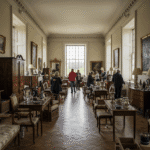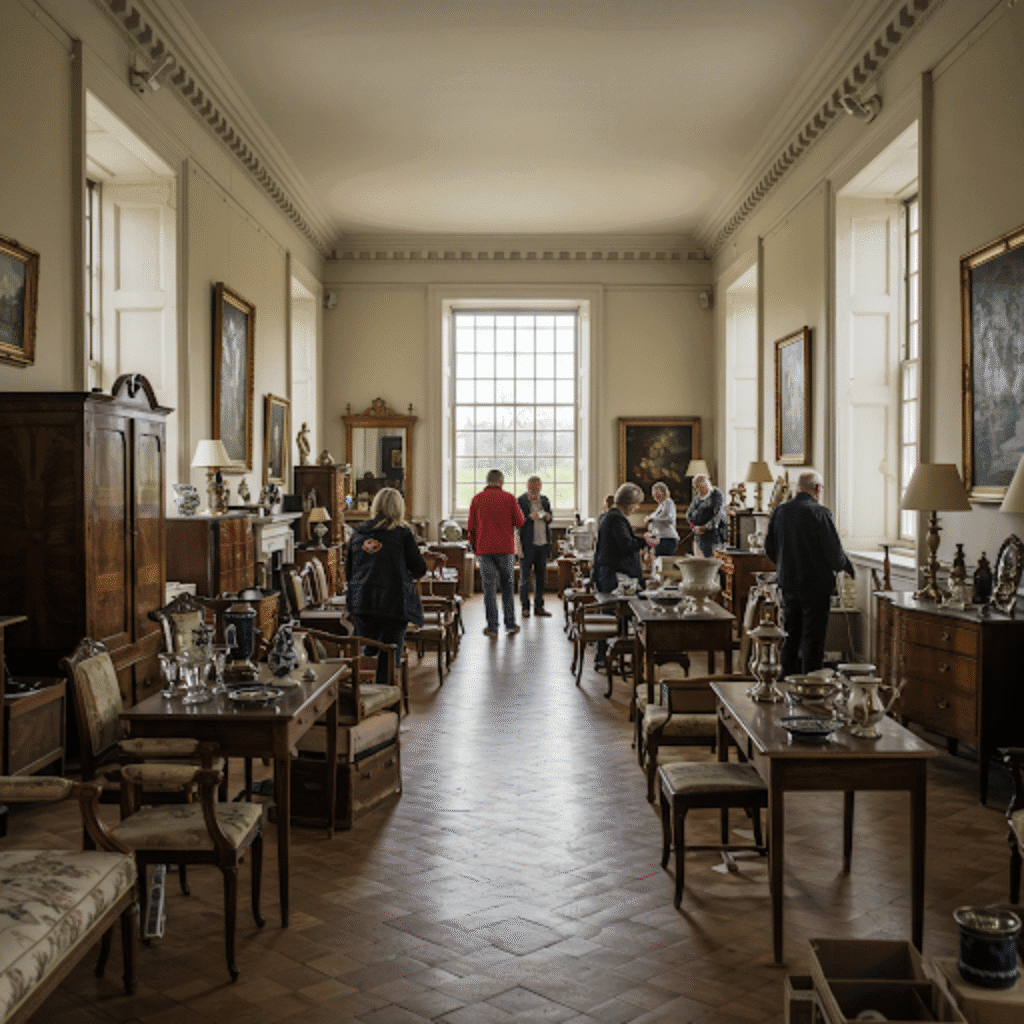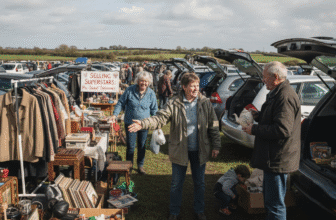
The Thrill of the Chase: Unlocking the Secrets of the Saleroom
Step into the world of the saleroom, and you enter a realm buzzing with anticipation, history, and the tantalising possibility of discovery. Far removed from the sterile predictability of high street retail, the auction house saleroom offers a unique and often exhilarating experience. It’s a place where treasures change hands, fortunes can be made (or spent!), and stories unfold with the rap of a gavel. Whether you’re a seasoned collector, a curious novice, or someone looking to sell unwanted heirlooms, understanding the dynamics of the saleroom is key to navigating this fascinating environment.
For many, the term “saleroom” conjures images of grand rooms filled with dusty antiques, presided over by a fast-talking auctioneer. While this traditional image certainly holds true for many established auction houses across the United Kingdom, the modern saleroom is a far more diverse and accessible place than ever before. From local general sales offering everything from furniture to garden tools, to specialist auctions featuring rare wines, classic cars, or contemporary art, there’s a saleroom catering to almost every interest and budget.
This article delves into the heart of the saleroom experience. We’ll explore the unique atmosphere, the incredible variety of items that pass through, the intricacies of the bidding process, and offer practical tips for both buyers and sellers looking to participate in the exciting world of auctions.

The Unique Atmosphere: More Than Just Buying and Selling
A saleroom isn’t just a place of commerce; it’s a theatre of human interaction and desire. The atmosphere on auction day, and often during the preceding viewing days, is palpable.
The Buzz and Energy
There’s an undeniable energy in a busy saleroom. It stems from the mix of people present – seasoned dealers spotting potential profit, passionate collectors hoping to acquire a long-sought-after piece, interior designers sourcing unique items for clients, and individuals simply caught up in the excitement. Conversations hum, eyes dart across the room assessing the competition, and a sense of shared purpose – the acquisition or disposal of goods – unites everyone.
The Star of the Show: The Auctioneer
At the centre of it all is the auctioneer. Far more than just someone who calls out numbers, a skilled auctioneer is a performer, a negotiator, and a master of pace. They control the flow of the auction, inject humour, build suspense, and encourage bidding. Their rhythmic chant, keen eye for spotting bids (even the subtlest nod or raised eyebrow), and the decisive fall of the hammer are iconic elements of the saleroom experience. They need to be knowledgeable about the items being sold, adept at managing the room, and capable of maintaining momentum, sometimes for hours on end.
The Viewing Days: Hands-On Discovery
Before the main event, auction houses hold viewing days. This is a crucial opportunity for potential buyers to inspect the lots (the individual items or groups of items being sold) up close. Unlike online shopping or catalogue Browse, viewing days allow you to physically handle objects, assess their condition, gauge their size and presence, and look for maker’s marks or signs of restoration. It’s a chance to engage your senses – feel the patina on antique wood, examine the intricacies of a piece of jewellery, or simply get a better feel for an item than a photograph can convey. This is also when you can ask questions of the auction house specialists who are usually on hand.
A Cornucopia of Goods: What Treasures Await?
The sheer variety of items that pass through UK salerooms is staggering. While antiques and fine art are staples, the scope is far broader.
- Furniture: From imposing Georgian sideboards and elegant Regency chairs to mid-century modern design classics and contemporary pieces.
- Fine Art: Paintings (oils, watercolours, prints), drawings, sculpture across all periods and styles.
- Ceramics and Glass: Pottery, porcelain (from factories like Worcester, Derby, Meissen, Sèvres), studio pottery, decorative glass, and tableware.
- Jewellery and Watches: Antique and modern pieces, precious gemstones, signed designer items, pocket watches, and luxury wristwatches.
- Collectibles: Stamps, coins, medals, toys (Dinky, Hornby), militaria, books, manuscripts, ephemera, vinyl records, memorabilia (film, music, sport).
- Silver and Metalware: Sterling silver tableware, flatware, decorative objects, pewter, brass, and copperware.
- Clocks and Scientific Instruments: Longcase clocks, bracket clocks, barometers, telescopes, microscopes.
- Rugs and Textiles: Oriental carpets, antique tapestries, vintage fashion, lace.
- Specialist Categories: Many auction houses hold dedicated sales for classic cars, motorcycles, wine, whisky, architectural salvage, and even property.
General sales offer a mix of everything, often providing the best chance for uncovering unexpected bargains. Specialist sales, conversely, attract knowledgeable collectors and dealers, often achieving higher prices for specific categories but offering curated, high-quality selections.
Navigating the Auction Process: From Registration to Hammer Fall
Participating in an auction might seem daunting initially, but the process is relatively straightforward once understood.
1. Registration
To bid, you must first register with the auction house. This usually involves providing your name, address, contact details, and sometimes proof of identity and a payment method (like a debit or credit card). Upon registration, especially for in-person bidding, you’ll typically be given a paddle with a unique bidder number. This paddle is what you raise to indicate your bid to the auctioneer.
2. Viewing and Research
As mentioned, attending the viewing is vital. Examine lots carefully for condition, damage, or restoration – items are sold “as seen,” and descriptions in catalogues, while usually accurate, are not warranties. Catalogues, available in print or online, provide descriptions, estimates (the price range the auctioneer expects the lot to fetch), and images. Use the estimates as a guide, but conduct your own research into comparable items to determine your maximum bid.
3. Understanding Bidding Methods
There are several ways to place a bid:
- In-Person Bidding: The traditional method. Attend the auction, wait for the lot you’re interested in, and raise your paddle clearly when you wish to bid at the price the auctioneer is asking.
- Absentee Bid (Commission Bid): If you cannot attend, you can leave a commission bid beforehand. You specify the maximum amount you’re willing to pay for a lot (excluding buyer’s premium). The auctioneer or a member of staff will then bid on your behalf, trying to secure the item for you at the lowest possible price up to your maximum.
- Telephone Bidding: For higher-value lots, you can often arrange to bid live via telephone. A member of the auction house staff will call you shortly before the lot comes up and relay the auctioneer’s requests and your bids in real-time. This requires pre-arrangement.
- Online Bidding: Most auction houses now offer live online bidding through their own websites or third-party platforms (like The Saleroom or EasyLiveAuction). You watch a live stream of the auction and click a button to place bids. Be aware that online bidding often incurs an additional surcharge on top of the standard buyer’s premium.
4. The Auctioneer’s Role and the Hammer Price
The auctioneer introduces each lot and typically starts the bidding below the low estimate. They will call out increasing bid increments. Bids come from the room, online platforms, telephones, and commission bids. The auctioneer coordinates these competing bids until only one bidder remains. After a final call (“Going once, going twice…”), the hammer falls, signifying the sale to the highest bidder at the “hammer price”. If bidding doesn’t reach the “reserve price” (a confidential minimum price agreed upon by the seller and auction house), the lot will remain unsold or “bought in”.
5. Post-Auction Costs: Buyer’s Premium and Other Fees
Crucially, the hammer price is *not* the final amount you pay. On top of the hammer price, buyers must pay a Buyer’s Premium. This is a percentage of the hammer price (typically ranging from 15% to 30%, clearly stated in the auction terms). VAT is usually charged on the Buyer’s Premium. Additionally, for online bidding, there might be an extra percentage (often 3-5%). Certain items, particularly works of art by living artists or those who died within the last 70 years, may also be subject to Artist’s Resale Right (ARR) if the hammer price exceeds a certain threshold (currently €1,000). Always factor these additional costs into your maximum budget.
Top Tips for Saleroom Buyers
- Research Thoroughly: Understand the item, its market value, and typical condition issues.
- Inspect Carefully: Attend viewings or request detailed condition reports and extra images if bidding remotely. Remember “caveat emptor” (buyer beware).
- Set a Strict Budget: Calculate your maximum hammer price by factoring in the Buyer’s Premium, potential VAT, online fees, and ARR. Don’t exceed it in the heat of the moment.
- Read the Terms & Conditions: Understand payment deadlines, collection requirements, and specific fees.
- Stay Calm: Auctions can be exciting, but avoid getting drawn into bidding wars that push prices beyond sensible levels. There will always be another auction.
- Factor in Logistics: Consider how you will collect or arrange shipping for your purchases, especially for large or fragile items. Auction houses often have recommended shippers.
Guidance for Selling at Auction
Selling through a saleroom can be an effective way to achieve a fair market price for your items.
- Choose the Right Auction House: Consider their specialisms, location, marketing reach (local vs. international), commission rates, and track record with similar items. Get valuations from a couple of different houses if possible.
- Get a Valuation: Auction houses offer free preliminary valuations based on photos or descriptions. For a formal valuation and consignment, a specialist will usually need to see the item. Be realistic about reserves.
- Understand the Consignment Agreement: This legal document outlines the terms, including the seller’s commission (a percentage deducted from the hammer price), any charges for loss/damage warranty, illustration fees, transport, and the agreed reserve price.
- Marketing Matters: The auction house will catalogue, photograph, and market your items to potential buyers through their website, online platforms, catalogues, and targeted advertising. Good presentation is key.
- Patience with Payment: After a successful sale, there’s a waiting period while the auction house collects payment from the buyer. Settlement to the seller typically occurs around 28-35 days after the auction, minus the agreed deductions.
The Digital Revolution: Online Auctions Ascendant
Technology has profoundly impacted the saleroom. While the physical auction retains its charm, online bidding platforms have democratised access, allowing people worldwide to participate in auctions from their homes. This has vastly increased the potential buyer base for sellers and offered unprecedented convenience for buyers.
Live online bidding provides real-time participation, while timed online auctions (similar to eBay) run entirely digitally over a set period. The quality of online catalogues, with multiple high-resolution images and detailed descriptions, has become paramount. However, the inability to physically inspect items remains a drawback for some buyers, emphasizing the importance of thorough condition reports and trusting the auction house’s expertise.
Beyond Antiques: The Modern Auction Landscape
The perception of auction houses solely dealing in dusty relics is outdated. Salerooms are vibrant marketplaces for a much wider range of goods reflecting contemporary tastes and interests. Auctions dedicated to 20th-century design, contemporary art, luxury handbags, fine wines and spirits, classic cars, and pop culture memorabilia are increasingly popular and attract a diverse, often younger, clientele. This evolution ensures the saleroom remains relevant and exciting in the modern consumer landscape.
The Enduring Appeal
The saleroom, whether experienced in person amidst the buzz of the crowd or through the focused interface of an online platform, offers something unique: the thrill of the unknown, the potential for discovery, and the satisfaction of acquiring (or successfully selling) something with history, character, or rarity. It’s a place where knowledge, timing, and sometimes a bit of luck converge. It requires research and careful budgeting, but the rewards – owning a piece of history, finding that perfect decorative item, or achieving a great price for your goods – make the world of auctions endlessly fascinating. So, why not explore your local saleroom or browse an online catalogue? You never know what treasures you might uncover.







